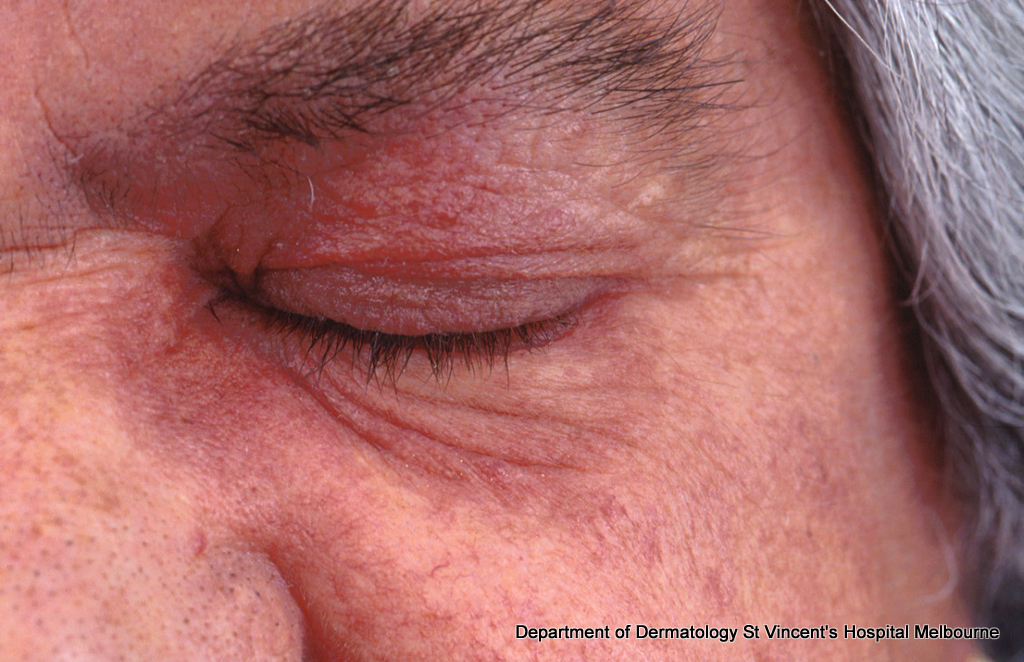Dermatomyositis is a condition where there is inflammation in skin, muscles and blood vessels. The condition is more common in females. It can affect children usually before the age of 10 years as well as adults usually over the age of 40 years.
The cause of dermatomyositis is unknown. The immune system may be triggered abnormally by an infection or cancer.
The appearance of dermatomyositis can be quite variable. Muscle involvement is the prominent feature in some cases. In other cases, skin changes occur without or before muscle involvement.
Skin involvement commonly shows as a rash around the eyes with swelling of the eyelids and a rash on the knuckles of the hands.

There may also be ragged nail cuticles as well as a rash over other joints, on the thighs and the upper chest and back.

The main concern with dermatomyositis in adults is the possibility of an underlying cancer that has caused the condition. Up to 30% of adults with dermatomyositis are found to have an underlying cancer. Common associated cancers are from the lung, breast, ovaries, uterus, stomach and rectum. Cancers may be present at the time of diagnosis or may occur later. It is important that affected people have appropriate follow-up and screening.
Other problems may include difficulty breathing or swallowing due to muscle weakness. There may also be inflammation and scar tissue in important organs such as the heart and lungs leading to heart and lung failure. Inflammation and blockage in the blood vessels supplying the bowel may cause complications.
A rare feature in adults is calcium deposits in the muscles and just below the skin.
Childhood cases of dermatomyositis are very rarely associated with cancer. The main concerns are muscle weakness, sensitivity to sunlight and calcium deposits in muscles and under the skin.
The condition is usually diagnosed from the appearance of skin as well as a history of muscle weakness or pain. Skin and/or muscle biopsies or muscle MRI, are helpful in confirming the diagnosis. The diagnosis can also be confirmed with blood tests, which show raised muscle enzymes.
- Further assessment
The affected person needs to be thoroughly evaluated to assess the extent of the condition and involvement of other organs such as lungs, heart and bowel. Further investigations are needed to search for, or exclude, an underlying cancer especially in adults. This involves a general physical examination and radiology tests such a chest X-ray, CT scans, mammograms and ultrasound scans. Further tests such as heart conduction studies (ECG), pap smears and blood tests are also needed to look for underlying problems.
- General measures include rest and sun protection.
- Specific treatments
- The first goal of treatment is to reverse the muscle weakness and prevent complications such as calcium deposits or other damage to the tissues.
- Treatment usually involves steroid tablets at relatively high doses to try to turn off the process.
- Further medications (such as azathioprine, methotrexate and cyclosporine) may be required to suppress the immune system and settle the inflammation.
- In cases that do not respond to treatment, an infusion directly into the blood stream called “intravenous immunoglobulin” may be used. Also an antibody treatment called Rituximab has been shown to be beneficial.
- Steroid creams and an antimalarial tablet called plaquenil can be used for skin involvement in addition to sunscreens and sun protective measures
- Follow up
Regular follow up and screening, especially in the first three years after diagnosis, is required because of the association with an underlying cancer that may not be present at the time of diagnosis.
This information has been written by Dr Brad Jones
Disclaimer
2019 © Australasian College of Dermatologists.
You may use for personal use only. Please refer to our disclaimer.